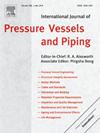Study on the effect of tempering temperature on the properties of Cr-Mo steel in high-pressure gaseous hydrogen
IF 3
2区 工程技术
Q2 ENGINEERING, MECHANICAL
International Journal of Pressure Vessels and Piping
Pub Date : 2025-01-23
DOI:10.1016/j.ijpvp.2025.105449
引用次数: 0
Abstract
Quenched and tempered Cr-Mo steel is commonly used in the construction of seamless hydrogen storage vessels. The resistance of such material to hydrogen embrittlement is significantly influenced by its strength and microstructure, both of which are closely related to the tempering temperature during heat treatment. Thus, optimizing the tempering temperature can potentially enhance the performance of Cr-Mo steel in high-pressure gaseous hydrogen and extend the fatigue life of seamless hydrogen storage vessels. In this study, seamless hydrogen storage vessels designed for a pressure of 50 MPa were tempered at temperatures ranging from 580 °C to 660 °C. Specimens sampled from these vessels were subjected to fatigue crack growth rate (FCGR) tests and threshold stress intensity factor for hydrogen-assisted cracking (KIH) tests in 50 MPa gaseous hydrogen, and hydrogen permeation tests were also conducted. Additionally, a fatigue life analysis of the vessels was performed using the fracture mechanics method based on the test results of Cr-Mo steel. The results indicate that increasing tempering temperature reduces the FCGR and improves KIH of Cr-Mo steel in high-pressure gaseous hydrogen, thereby extending the fatigue life of seamless hydrogen storage vessels. Simultaneously, the increase in tempering temperature leads to a greater quantity and more dispersed distribution of precipitated carbides. These carbides, serving as irreversible hydrogen traps, effectively hinder the diffusion of hydrogen atoms, which is a key factor contributing to the enhanced resistance of Cr-Mo steel to hydrogen embrittlement with higher tempering temperatures.
高压气态氢中回火温度对Cr-Mo钢性能影响的研究
调质Cr-Mo钢常用于无缝储氢容器的建造。这种材料的抗氢脆性能受其强度和微观组织的显著影响,这两者都与热处理时的回火温度密切相关。因此,优化回火温度可以提高Cr-Mo钢在高压气体氢中的性能,延长无缝储氢容器的疲劳寿命。在这项研究中,设计压力为50 MPa的无缝储氢容器在580°C到660°C的温度范围内进行回火。对试样进行了疲劳裂纹扩展速率(FCGR)试验和氢辅助开裂阈值应力强度因子(KIH)试验,并进行了氢渗透试验。此外,基于Cr-Mo钢的试验结果,采用断裂力学方法对容器进行了疲劳寿命分析。结果表明,提高回火温度可降低Cr-Mo钢在高压气态氢中的FCGR,提高其KIH,从而延长无缝储氢容器的疲劳寿命。同时,回火温度的升高导致析出碳化物的数量增加,分布更加分散。这些碳化物作为不可逆的氢陷阱,有效地阻碍了氢原子的扩散,这是Cr-Mo钢在较高回火温度下抗氢脆性能增强的关键因素。
本文章由计算机程序翻译,如有差异,请以英文原文为准。
求助全文
约1分钟内获得全文
求助全文
来源期刊
CiteScore
5.30
自引率
13.30%
发文量
208
审稿时长
17 months
期刊介绍:
Pressure vessel engineering technology is of importance in many branches of industry. This journal publishes the latest research results and related information on all its associated aspects, with particular emphasis on the structural integrity assessment, maintenance and life extension of pressurised process engineering plants.
The anticipated coverage of the International Journal of Pressure Vessels and Piping ranges from simple mass-produced pressure vessels to large custom-built vessels and tanks. Pressure vessels technology is a developing field, and contributions on the following topics will therefore be welcome:
• Pressure vessel engineering
• Structural integrity assessment
• Design methods
• Codes and standards
• Fabrication and welding
• Materials properties requirements
• Inspection and quality management
• Maintenance and life extension
• Ageing and environmental effects
• Life management
Of particular importance are papers covering aspects of significant practical application which could lead to major improvements in economy, reliability and useful life. While most accepted papers represent the results of original applied research, critical reviews of topical interest by world-leading experts will also appear from time to time.
International Journal of Pressure Vessels and Piping is indispensable reading for engineering professionals involved in the energy, petrochemicals, process plant, transport, aerospace and related industries; for manufacturers of pressure vessels and ancillary equipment; and for academics pursuing research in these areas.

 求助内容:
求助内容: 应助结果提醒方式:
应助结果提醒方式:


